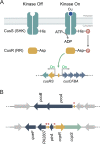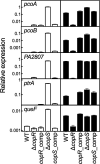The Two-Component System CopRS Maintains Subfemtomolar Levels of Free Copper in the Periplasm of Pseudomonas aeruginosa Using a Phosphatase-Based Mechanism
- PMID: 33361129
- PMCID: PMC7763554
- DOI: 10.1128/mSphere.01193-20
The Two-Component System CopRS Maintains Subfemtomolar Levels of Free Copper in the Periplasm of Pseudomonas aeruginosa Using a Phosphatase-Based Mechanism
Abstract
Two-component systems control periplasmic Cu+ homeostasis in Gram-negative bacteria. In characterized systems such as Escherichia coli CusRS, upon Cu+ binding to the periplasmic sensing region of CusS, a cytoplasmic phosphotransfer domain of the sensor phosphorylates the response regulator CusR. This drives the expression of efflux transporters, chaperones, and redox enzymes to ameliorate metal toxic effects. Here, we show that the Pseudomonas aeruginosa two-component sensor histidine kinase CopS exhibits a Cu-dependent phosphatase activity that maintains CopR in a nonphosphorylated state when the periplasmic Cu levels are below the activation threshold of CopS. Upon Cu+ binding to the sensor, the phosphatase activity is blocked and the phosphorylated CopR activates transcription of the CopRS regulon. Supporting the model, mutagenesis experiments revealed that the ΔcopS strain exhibits maximal expression of the CopRS regulon, lower intracellular Cu+ levels, and increased Cu tolerance compared to wild-type cells. The invariant phosphoacceptor residue His235 of CopS was not required for the phosphatase activity itself but was necessary for its Cu dependency. To sense the metal, the periplasmic domain of CopS binds two Cu+ ions at its dimeric interface. Homology modeling of CopS based on CusS structure (four Ag+ binding sites) clearly supports the different binding stoichiometries in the two systems. Interestingly, CopS binds Cu+/2+ with 3 × 10-14 M affinity, pointing to the absence of free (hydrated) Cu+/2+ in the periplasm.IMPORTANCE Copper is a micronutrient required as cofactor in redox enzymes. When free, copper is toxic, mismetallating proteins and generating damaging free radicals. Consequently, copper overload is a strategy that eukaryotic cells use to combat pathogens. Bacteria have developed copper-sensing transcription factors to control copper homeostasis. The cell envelope is the first compartment that has to cope with copper stress. Dedicated two-component systems control the periplasmic response to metal overload. This paper shows that the sensor kinase of the copper-sensing two-component system present in Pseudomonadales exhibits a signal-dependent phosphatase activity controlling the activation of its cognate response regulator, distinct from previously described periplasmic Cu sensors. Importantly, the data show that the system is activated by copper levels compatible with the absence of free copper in the cell periplasm. These observations emphasize the diversity of molecular mechanisms that have evolved in bacteria to manage the copper cellular distribution.
Keywords: Pseudomonas aeruginosa; copper; homeostasis; periplasm; two-component regulatory systems.
Copyright © 2020 Novoa-Aponte et al.
Figures









Similar articles
-
Mechanism of metal ion-induced activation of a two-component sensor kinase.Biochem J. 2019 Jan 15;476(1):115-135. doi: 10.1042/BCJ20180577. Biochem J. 2019. PMID: 30530842 Free PMC article.
-
The Extracellular Electron Transport Pathway Reduces Copper for Sensing by the CopRS Two-Component System under Anaerobic Conditions in Listeria monocytogenes.J Bacteriol. 2023 Jan 26;205(1):e0039122. doi: 10.1128/jb.00391-22. Epub 2023 Jan 9. J Bacteriol. 2023. PMID: 36622231 Free PMC article.
-
Copper homeostasis networks in the bacterium Pseudomonas aeruginosa.J Biol Chem. 2017 Sep 22;292(38):15691-15704. doi: 10.1074/jbc.M117.804492. Epub 2017 Jul 31. J Biol Chem. 2017. PMID: 28760827 Free PMC article.
-
Escherichia coli mechanisms of copper homeostasis in a changing environment.FEMS Microbiol Rev. 2003 Jun;27(2-3):197-213. doi: 10.1016/S0168-6445(03)00049-4. FEMS Microbiol Rev. 2003. PMID: 12829268 Review.
-
Metal export by CusCFBA, the periplasmic Cu(I)/Ag(I) transport system of Escherichia coli.Curr Top Membr. 2012;69:163-96. doi: 10.1016/B978-0-12-394390-3.00007-0. Curr Top Membr. 2012. PMID: 23046651 Review.
Cited by
-
Development of a two component system based biosensor with high sensitivity for the detection of copper ions.Commun Biol. 2024 Oct 29;7(1):1407. doi: 10.1038/s42003-024-07112-6. Commun Biol. 2024. PMID: 39472725 Free PMC article.
-
Advances in Understanding of the Copper Homeostasis in Pseudomonas aeruginosa.Int J Mol Sci. 2021 Feb 19;22(4):2050. doi: 10.3390/ijms22042050. Int J Mol Sci. 2021. PMID: 33669570 Free PMC article. Review.
-
The Campylobacter jejuni BumS sensor phosphatase detects the branched short-chain fatty acids isobutyrate and isovalerate as direct cues for signal transduction.mBio. 2025 Feb 5;16(2):e0327824. doi: 10.1128/mbio.03278-24. Epub 2024 Dec 13. mBio. 2025. PMID: 39670710 Free PMC article.
-
Copper microenvironments in the human body define patterns of copper adaptation in pathogenic bacteria.PLoS Pathog. 2022 Jul 21;18(7):e1010617. doi: 10.1371/journal.ppat.1010617. eCollection 2022 Jul. PLoS Pathog. 2022. PMID: 35862345 Free PMC article. Review.
-
Metal Messengers: Communication in the Bacterial World through Transition-Metal-Sensing Two-Component Systems.Biochemistry. 2023 Aug 15;62(16):2339-2357. doi: 10.1021/acs.biochem.3c00296. Epub 2023 Aug 4. Biochemistry. 2023. PMID: 37539997 Free PMC article. Review.
References
-
- Fraústo da Silva JJR, Williams RJP. 2001. The biological chemistry of the elements: the inorganic chemistry of life, 2nd ed Oxford University Press, Oxford, United Kingdom.
Publication types
MeSH terms
Substances
Grants and funding
LinkOut - more resources
Full Text Sources

